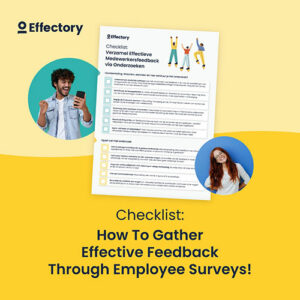Employee surveys can be an incredibly tense time for management as this reflects how employees really feel about the leadership within the organization. What is the best way to deliver feedback to leadership? And how can you, as a leader, open yourself up to it?
How to give feedback to your boss? Importance of feedback in leadership development

Feedback results
When receiving the results, the first thing management tends to look at are the scores given to leadership. If the outcome is positive or better than the previous survey, there are sighs of relief and happiness. But if the leadership feedback results are lower than expected, it can cause some sleepless nights. This is not uncommon, because everybody wants to be appreciated. And that goes for leadership as well.
Leadership feedback survey
However, such results can offer opportunities. They can create the right momentum to address any discrepancies that have been laying beneath the surface or for coworkers to seek clarification or discuss certain issues at hand.
If the scores for leadership from an employee survey are below expectations, then this should be taken as a sign. It will be worth the time to figure out where it is coming from. This can be best done via separate feedback sessions. It may sound scary because it is, at first. But remember: practice makes perfect.
1. Do not take it too personally
For management, it can be hard not to take this kind of leadership feedback personally. At the end of the day, it does relate to the way you function within your role. However, bear in mind that the results from an employee survey are not about you as a person, but about your behavior in relation to others within the company. Instead, consider this as a learning opportunity.
There could be a lot going on within your organization. Maybe your team needs a speaking to, from time to time, to address any behavioral issues or concerns. This may not be the best way to get them to like you, even if it is justified and a long-term solution for the team itself. A lower score does not mean that you are a bad leader or manager, but it is a sign that should be taken seriously. And if you would like to benefit from this opportunity, you will have to open yourself up to it.
Do not jump into either the defense or offense. It is not about right or wrong, but about the learning experience that can help develop a new behavior. Always assume the other person has good intentions. Try to be curious about their perspective and their input.
How to gather feedback from your employees
The definitive checklist for creating your employee engagement survey.
Download2. Do not expect a perfect leadership feedback conversation
Feedback comes with quite a few rules. There are a lot of do’s and don’ts, such as: only speak for yourself, provide clear and concise examples of certain behaviors, and try to explain how it affects you. Make sure to paraphrase to avoid miscommunication and to confirm you understood each other correctly.
Do not try to create the perfect leadership feedback conversation as this can force both you and the other party into an uncomfortable position, creating an obstacle instead. In turn, this can make it harder to get the conversation started. It is of more importance that you are not afraid to initiate the first step.
If your expectations remain open, you remove any potential discomfort that such a conversation may create. This is not like flipping a switch, so do not expect it to be easy. The process of providing and receiving feedback comes with a learning curve. It is a skill, after all.
3. Create a safe (online) space
Ensure there is a safe space for both leadership and employees. Do not host any leadership feedback sessions in the office garden or in an open office space with many windows, allowing passersby a glance into the room.
Are you having the conversation via a phone call or online meeting? Make sure you are in a quiet place and you are not disturbed. With these kind of conversations it really helps to turn on your camera so you can see each other.
Take your time to create a safe space for these conversations, especially if the team is not used to providing feedback. In these instances, it can be helpful to organize team outings where you venture into the outdoors or simply go for a walk around the park together.
4. Be open to have a mediator lead the discussion instead
If the team struggles to setup or deal with feedback sessions, it can help to involved a mediator. Their presence can also be a confidence booster to start these conversations.
Whitepaper: 7 Tips for your employee survey
Download this whitepaper and receive 7 tips to think about before starting your next employee survey, as well as tricks to avoid common pitfalls.
Download5. Be prepared to show emotion
Bear in mind that a feedback session may invoke emotions in all parties involved. This can occur before, during, or after the conversation has been had.
For management: their place is slightly above the team in the hierarchy, which can make them feel somewhat lonely. While they may want to take this opportunity to show some vulnerability, they may also fear this can affect their authority. Apart from that, a low score for leadership in an employee survey may also lead to experiencing fear, disappointment, anger or sadness. Or, simultaneously, all the above.
Providing leadership feedback is a hectic time for employees as well. They depend on their leadership and not just for future evaluations. Unfortunately, there are some managers who abuse their position to retaliate against the critical feedback received by giving their employees negative evaluations in return. If an employee already shares this negative experience, it can affect any of the current feedback sessions.
6. Be emotional in moderation
Feedback sessions conjure emotions in general. There is no reason to fear them. In fact, showing emotions can help convey the message you are trying to send. But do not let it dominate the conversation as that can drown everyone out. If emotions start to take over, take a step back from the topic, and discuss it at a later stage when they have settled.
However, lack of emotion is not the correct approach either. Without it, you may not be able to communicate your perspective properly to the other parties involved. For instance, when a compliment is given without any sign of emotion, the recipient may have a hard time believing it to be true. When it comes to emotions, try to walk the line amidst the two extremes.
7. Consistency is key
Feedback sessions take time. Relationship difficulties are not resolved after one conversation, they need consistent reflection. The same applies to feedback sessions in the workplace: they should be conducted on a regular basis. This allows for the entire team to devote the time and attention it requires.
Hang in there
Once you learn how to deliver constructive leadership feedback in a consistent time and manner as a team, you will create a safe space filled with trust for everyone involved. In time, this can help team members to lower their defenses and show some vulnerability.
This helps you create a safe environment for all. Once everyone feels comfortable in the workplace, they will not be afraid to be themselves. In turn, this can build a better team that delivers better results.
Employee Engagement
Increase employee engagement through action-oriented feedback. Using a single platform, you can collect reliable data, analyze the results, and share insights.
view employee survey solution
